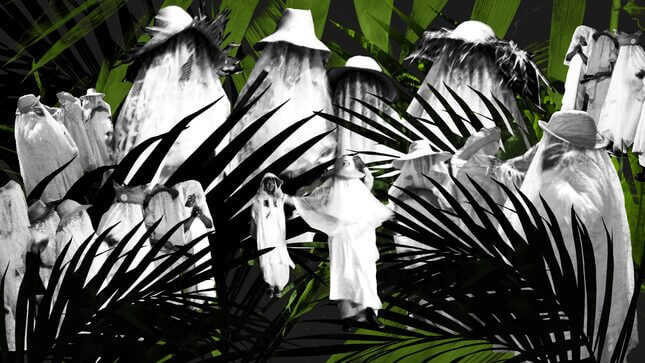
Illustration: Elena Scotti (Photos: Tarisai Ngangura, Wikimedia Commons, Shutterstock)
The shrieking sliced through the cloudy night and drowned out the music blasting from a speaker nearby. It was 9 p.m. in Saubara, a town of about 12,000 people in Brazil’s northeastern state of Bahia. Although the party wouldn’t officially start until 3 a.m., crowds were already outside waiting in anticipation. It was July 2nd, the last day of celebrations marking Bahia’s independence from Portugal in 1823. The festivities began the day before with samba and beer followed by street parties and fireworks at night. Today, however, the partygoers had come to see the women in white, who were shrieking and dashing through the streets in pairs, eagerly awaiting the late hour. “Olha o mingau! Look at the porridge!” the women repeated, between intermittent screams. Their yells were high-pitched and eerie, out of place in this picturesque town known for its fisherwomen, rendeiras (lacemakers) and basket weavers. The shrieking women in white, whose festa would start when most ended, are Saubara’s “Caretas do Mingau” (Masks of Porridge) and theirs is a history of subversive resistance, cunning, and heroism. It started—as many revolutions do—when a group of black women came up with a plan of action.
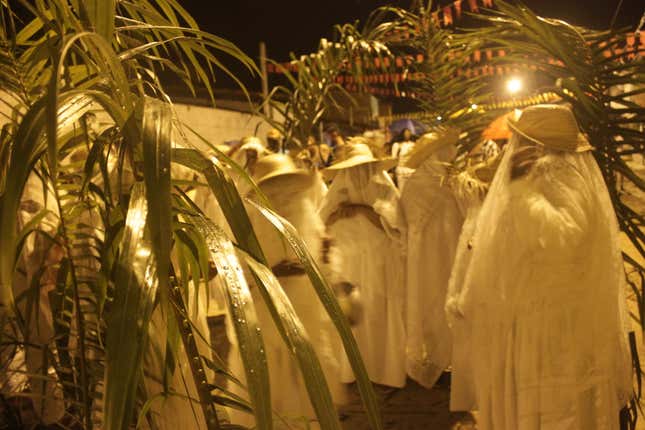
The women’s story begins in 1822 when, after 300 years of Portuguese colonization, Brazil’s war of independence began in Rio de Janeiro and quickly reached Bahia, land of sugarcane, cotton, and coffee. Saubara was then made up of tiny, scattered homes that largely housed black families, many of whom had escaped slavery or were recently freed. Their ancestral roots were West African, representative of the large populations kidnapped from Nigeria, Ghana, and Benin and offloaded onto Bahia’s coast. Though not much of a bustling, colonial city, Saubara’s location was of great strategic value. Located right at the mouth of the immense Rio Paraguaçu, the Portuguese saw the small town as a direct route to Cachoeira, a city on the river bank. Cachoeira was rich in resources, including sugar cane and African labor, and was also the economic stalwart of imperial Portugal. Saubara was the perfect place to coordinate an attack on the Northeastern Brazilians fighting for independence. With modern weaponry, a seemingly ceaseless supply of men and a deep conviction in the inferiority of the locals, a Portuguese victory seemed inevitable.
By 2:45 a.m., a light rain had slowly started to descend on Saubara. The streets were quieter as the shadows added a layer of gloom to the night. Those who still remained outside were Afro-Brazilian youth, huddled together in small groups under street lights and scrolling through their phones while they shared buckets of popcorn. A young man of about 21 broke away from one clique and walked over to me. “You’re here for the Caretas? That’s good. Are you making a film? I’m a theater student and we made a documentary on them last year. They are really great. Muito legal. Me and my friends have been waiting here all night.” He continued uninterrupted, looking straight ahead at the street behind me as I listened to the deluge of information tumbling out of his mouth and fueled by beer and Pepsi. “You know I used to be afraid of the Caretas when I was younger. I thought they were evil and scary. I would run away when I saw them. But now I understand who they are. You can be my photographer tonight and take pictures of me and them!” This was the only conversation I’ve ever had where all my responses were delivered as genuine smiles. It’s not that I couldn’t speak, he just had more interesting things to say.
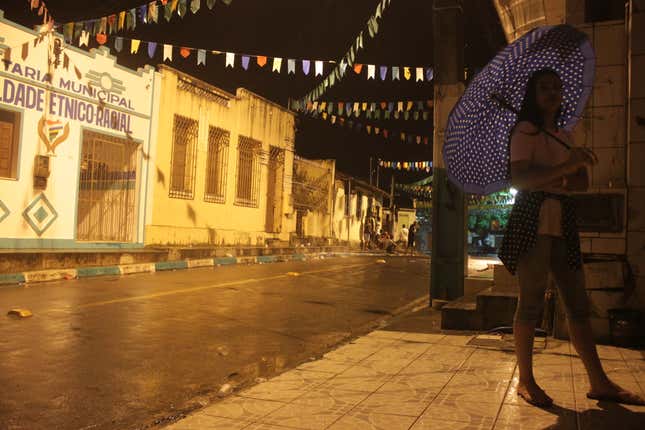
Around 3 a.m., people began to move towards the town entrance and gestured for me to do the same. They also yelled “Olha o Mingau,” but their cries were missing the ghostly timbre and instead filled with excitement. “It’s time now,” said Bel Saubara, a researcher and native of the town with which he shares his name. Saubara has spent over a decade compiling information on not only the Caretas but other local sisterhoods with a legacy of civil disobedience. After walking for about 10 minutes, the crowds made a left turn and their screaming was joined by the rapid-fire pounding of the congas, with the urgency shifting as the musicians kept an eye on the Caretas do Mingau, now grouped together and standing in front of them. We arrived at the house of the oldest Careta, Dona Maria Cruz who, at 96, could no longer walk with her sisters, so they came to her. Twenty of them—covered from head to toe in pristine white, with giant sheets covering their faces and draped over their wide-brimmed straw hats—were patiently waiting to begin their night. They would walk through the whole city shrieking, singing, slamming pots and pans and serving community members porridge (mingau) and liquor. They would do this until dawn to commemorate Bahia’s triumph over imperialism, and more importantly, to remember the role their little city, and the women who lived there, had played in that victory. The commemoration began in 1824 and, as the first sister began walking, the sound of pans slamming against one other rang through the narrow street, I thought back to the story Saubara had shared with me—one that almost two centuries earlier had brought us all here.
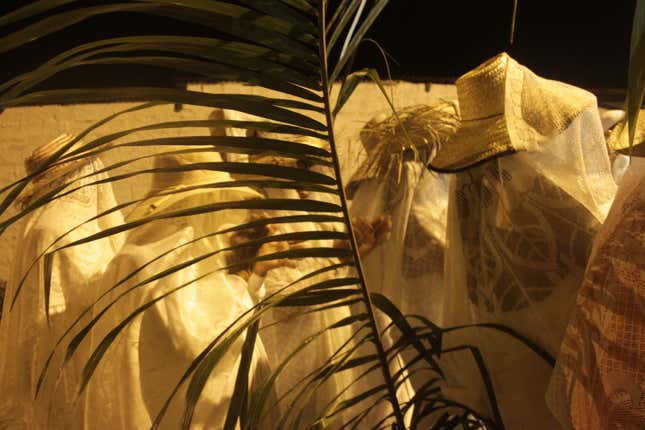
How were the people of Saubara to survive the onslaught of violence that the Portuguese were sure to bring to their small community in 1822? This was the question circling the minds of the women who stayed behind when Portuguese forces reached their town’s borders in November. The men of Saubara had placed themselves on the front lines, joined by boys who had been deemed strong enough to fight. After a while, the men began to run low on food supplies, water, weapons, and ammunition. Crossing enemy lines to make it home for aid was guaranteed suicide, but if they didn’t, defeat would be imminent. The women had also been counting the days and knew that help was needed at the front. It was at this moment that the war effort in Saubara took an eerie and surprising turn.
One night, a few minutes after midnight, resting Portuguese soldiers who had set up camp around the town heard a strange sound pierce the night sky. The soldiers were in unfamiliar terrain and unused to its nocturnal sounds; these noises were particularly different—unnatural and foreboding. Coming from deeply Christian Europe, staunchly religious and rabidly anti-black, the Portuguese believed the devil lurked among the pagan Africans. The Saubaran women understood the superstitions of their colonizers, deduced from a kind of clarity that comes when careful observation of the enemy is mandatory for survival and self-preservation. So, in the dead of night, they hurried through the streets shrieking and carrying piping hot pots of mingau (porridge) on top of their heads covered with white cloths thin enough to show a haunting outline, yet render their faces invisible. Porridge was the easiest to make and the quickest to transport. It was also a daily staple of life.
The women also carried weapons and water in their covered arms and some even dragged palm fronds along the ground to further unsettle their enemy. To the Catholic Portuguese, these ghostly white forms moving through the streets after the midnight hour, with their screams and deformed heads, were an unnerving, unearthly sight, and many abandoned their posts. No one imagined it was women underneath the layers of fabric carrying porridge and water, carrying out psychological warfare. It’s unknown for how long and how many times they were able to do this, but by 1823, the war was over and the Portuguese had retreated.
“They had thought they were being haunted,” Saubara told me. “At that time many people believed women didn’t belong in war. Their husbands thought they didn’t have the disposition for it and the Europeans thought they weren’t smart enough. They were not seen as a threat.” Much of the Caretas do Mingau’s history has been garnered from oral storytelling passed on through families, but diary entries from both Brazilian and Portuguese military generals described the resolve and resistance of the fighters in Saubara. General Labatut, a French mercenary conscripted to fight for Brazil spoke of what he called the feminine face of the Recôncavo (the geographical name for towns in Brazil’s Northeast), highlighting a particular day when “for over six hours they (women) were present on the combat field.”
The state of Bahia won its independence from Portugal in July of 1823, a full two months before Brazil. The women of Saubara began to commemorate their operation annually, leading to the party which has continued to this day. As profound and radical as their actions were, very little is known of the Caretas do Mingau—the sisterhood’s after-midnight walk is largely enjoyed by locals as a communal event. For the women in the sisterhood, the more local the better, and they appreciate the unity and closeness which exists when something belongs solely to the people who can truly appreciate its significance.
“If God allows it, I want to always be a part of Caretas de Mingau,” says 43-year-old Guiomar Freitas da Silva earnestly. I hope that I’ll always have the capacity to walk with them.” She’s been a part of the sisterhood for almost two decades, a family legacy she shares with Dona Antonia, her 80-year-old mother. The da Silva’s roots are planted deep in Saubara stretching down three generations. They were here before Saubara was officially declared a municipality in 1989. “The Caretas do Mingau not only represent the history of us, Saubarenses, but the history of Bahia and the history of the country and its fight for independence,” da Silva adds.
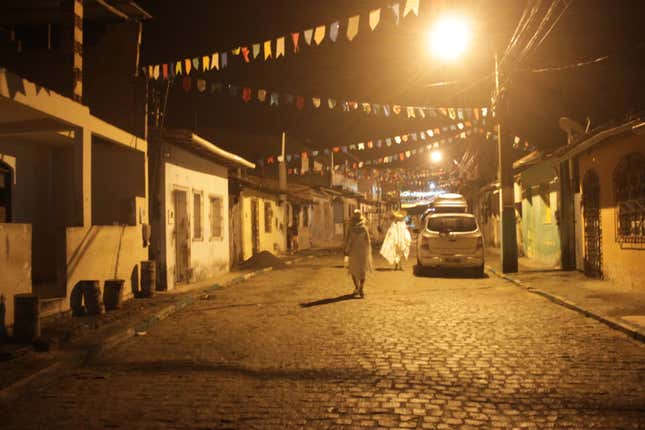
As we walked, Saubarenses who’d been sleeping peaked from their windows or came outside to see the action from their verandas. “Olha o mingauuu! Olha o mingau! Look at the porridge! Look at the porridge!” Having stopped at several houses to collect more porridge, along with boiled amendoim (nuts) and liquor, the party ended at 7 a.m. with everyone sufficiently fed and visibly inebriated. The slow rain had now become torrential but the crowd did not leave; instead, the pots and pans kept banging and the congas kept pounding. Early morning buses were starting to make their rounds and some of the Caretas began to leave. But others would stay, welcoming early risers with samba and drums.
I went back to the hostel and grabbed my backpack to catch the first bus back home. I was drenched, cold, and worried about my camera but I was also so thankful for the black women who came together in someone’s house over a century ago and made a plan.
Tari Ngangura is a journalist and photographer based in Brazil. She documents black lives around the globe; their histories, legacies, and movements. Her work has been featured in The New York Times, The Globe and Mail, New York Magazine, Hazlitt, VICE, Noisey, Catapult, The Fader, Flare Magazine, Gusher, and Rookie Mag. You can find her on Twitter @FungaiSJ.